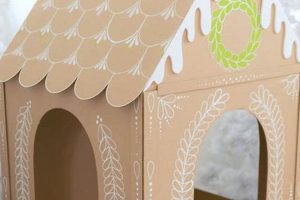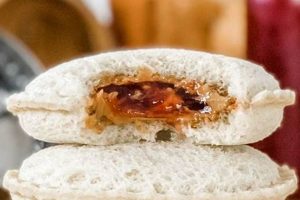A suspended interior design element replicating the appearance of atmospheric clouds, often incorporating light-emitting diodes (LEDs) to simulate sky-like illumination, provides an ambient lighting solution. Constructed primarily from lightweight materials such as polyester fiber fill or batting affixed to a backing, typically of wire mesh or a similar framework, it transforms the visual perception of a room’s ceiling. An example might involve creating a serene, diffused lighting effect in a bedroom by layering synthetic clouds over a pre-existing light fixture.
The utilization of such an installation offers several advantages. It provides a cost-effective method to enhance interior aesthetics, creating a unique and calming atmosphere within a space. Furthermore, the integrated lighting can improve overall room illumination, offering a softer, more diffused light compared to traditional fixtures. While the concept of decorative ceilings has existed for centuries, the accessibility of materials and lighting technology has popularized this particular form of ceiling art, enabling broader participation in its creation and adaptation to various styles.
The following sections will delve into the specific materials required for construction, detailed step-by-step instructions for assembly, safety precautions to consider during installation, and creative variations adaptable to individual preferences and room dimensions. Guidance on selecting appropriate lighting components and maintenance procedures will also be provided to ensure the longevity and safe operation of this unique decorative feature.
Essential Considerations for a DIY Cloud Ceiling
This section provides crucial advice for constructing a cloud ceiling, emphasizing safety, longevity, and aesthetic impact. Diligent adherence to these guidelines will help ensure a successful and visually appealing result.
Tip 1: Material Selection is Paramount: Opt for fire-retardant polyester fiber fill or batting. This minimizes the risk of fire hazards, particularly when coupled with lighting elements. Verify compliance with local fire safety regulations.
Tip 2: Secure Framework Construction: A robust and properly anchored framework is crucial for supporting the weight of the cloud material. Utilize wire mesh or lightweight wood framing, ensuring it is securely fastened to the existing ceiling structure with appropriate load-bearing hardware.
Tip 3: LED Lighting Integration: When incorporating LEDs, select low-voltage options designed for enclosed spaces. Proper heat dissipation is vital to prevent overheating and potential fire risks. Consult manufacturer guidelines for safe operating parameters.
Tip 4: Diffusion Layer Considerations: Employ a thin layer of translucent material, such as vellum paper or frosted plastic sheeting, between the LEDs and the cloud material. This will evenly diffuse the light, creating a more realistic and pleasing aesthetic.
Tip 5: Avoid Obstruction of Existing Fixtures: The cloud ceiling should not impede access to existing ceiling fixtures or smoke detectors. Ensure proper clearances for maintenance and safety inspections.
Tip 6: Proper Ventilation is Key: Design the installation to allow for adequate air circulation around lighting components. This will prevent heat buildup and extend the lifespan of the LEDs.
Tip 7: Secure All Wiring: All electrical wiring must be properly insulated and securely fastened to prevent shorts or loose connections. Consult a qualified electrician if unsure about any aspect of the electrical installation.
Adhering to these guidelines ensures a visually striking and, more importantly, a safe and durable cloud ceiling installation. Careful planning and meticulous execution are essential for long-term satisfaction and peace of mind.
The following sections will cover troubleshooting common issues encountered during installation and maintenance, as well as exploring advanced design techniques for more complex and visually compelling cloud ceiling projects.
1. Material Selection and the DIY Cloud Ceiling
Material selection critically influences the success and safety of any do-it-yourself cloud ceiling project. The choice of materials directly impacts not only the visual appeal and durability of the installation but also its fire resistance and potential health hazards. For instance, using untreated cotton batting in proximity to LED lighting introduces a significant fire risk. Similarly, employing low-quality adhesives can lead to off-gassing and indoor air pollution, affecting the health of occupants. Therefore, selecting appropriate materials is a foundational aspect of responsible cloud ceiling construction.
Specific examples of material choices and their consequences further illustrate this point. Fire-retardant polyester fiber fill, while potentially more expensive than alternative materials, offers superior fire resistance and minimizes the risk of combustion if the lighting system malfunctions. Furthermore, using lightweight, but sturdy, wire mesh for the supporting framework prevents sagging and ensures the structural integrity of the cloud ceiling over time. In contrast, substituting these materials with less suitable options, such as flammable craft foam or weak cardboard supports, can compromise the entire installation’s safety and longevity. Choosing appropriate LEDs with low heat emission reduces risks as well.
In conclusion, meticulous material selection forms the bedrock of a safe and aesthetically pleasing DIY cloud ceiling. It demands careful consideration of fire safety, structural integrity, and indoor air quality. While cost may be a factor, prioritizing appropriate materials mitigates risks and ensures a durable and visually compelling finished product. Neglecting this aspect can lead to dangerous and unsatisfactory results. Choosing wisely ensures a satisfying and safe outcome.
2. Framework Stability
Framework stability constitutes a critical determinant of the structural integrity and longevity of any “diy cloud ceiling” installation. Inadequate framework design or construction can result in sagging, detachment, or complete collapse of the cloud structure. The framework serves as the primary support system, bearing the weight of the cloud material, lighting components, and any additional decorative elements. Consequently, its stability directly influences the overall safety and aesthetic appeal of the finished product. For example, a flimsy wire frame may deform under the weight of dense polyester fiber fill, creating an uneven and unattractive cloudscape. Similarly, improperly secured attachment points to the existing ceiling can lead to catastrophic failure, posing a significant safety hazard to occupants.
The practical significance of understanding the relationship between framework s
tability and the overall success of a “diy cloud ceiling” manifests in several key areas. Accurate load calculations are essential to determine the appropriate gauge of wire or the dimensions of wooden framing members. Proper anchoring techniques, utilizing fasteners appropriate for the ceiling material (e.g., drywall anchors, toggle bolts), ensure a secure connection between the framework and the building structure. Furthermore, reinforcement strategies, such as cross-bracing or triangulation, can significantly enhance the rigidity and load-bearing capacity of the framework. A cloud ceiling with a large surface area will often need internal supports, preventing bowing of the supporting grid. Correctly executing these practical considerations transforms the feasibility and safety of the whole project.
In summary, framework stability is not merely a desirable feature, but an indispensable requirement for a safe and visually appealing “diy cloud ceiling”. Neglecting this aspect can lead to structural failure, safety hazards, and aesthetic disappointment. Understanding the principles of load distribution, employing appropriate construction techniques, and meticulously securing the framework to the existing ceiling are crucial for ensuring the long-term integrity and enjoyment of this unique interior design element.
3. Lighting Integration
Lighting integration is a core element in the successful implementation of a “diy cloud ceiling,” dictating both the aesthetic effect and the functional illumination provided by the installation. It goes beyond simple illumination, creating atmospheric depth and realism crucial to replicating a natural sky effect.
- Color Temperature Selection
The selection of LED color temperature significantly influences the perceived atmosphere. Warm white (2700-3000K) evokes a sunset or twilight feel, while cool white (5000-6500K) emulates daylight. Adjustable color temperature LED strips offer versatility, allowing simulation of different times of day. In a bedroom setting, warmer tones might be preferable for relaxation, while a home office might benefit from cooler, more energizing light.
- Brightness and Dimming Capabilities
Adequate brightness is essential for the cloud ceiling to function as a primary or secondary light source. Dimmable LEDs provide flexibility, enabling the adjustment of light intensity based on ambient conditions and desired mood. Integrated dimmers or smart home compatibility allows for convenient control. Insufficient brightness renders the cloud ceiling purely decorative, limiting its functional value.
- LED Strip Density and Placement
The density and placement of LED strips within the cloud structure directly impact the uniformity and intensity of light diffusion. Closely spaced LEDs minimize hot spots and create a more even glow. Strategic placement can highlight specific cloud formations or simulate natural light patterns. Sparse LED placement results in uneven illumination and reduces the overall impact of the design.
- Safety and Heat Dissipation
Proper heat dissipation is paramount to prevent overheating and extend the lifespan of LED components. Low-voltage LED systems, combined with appropriate heat sinks or ventilation strategies, mitigate the risk of fire hazards and premature failure. Enclosed cloud ceilings must allow for sufficient airflow to prevent heat buildup. Failure to address heat management can lead to safety risks and costly repairs.
These aspects of lighting integration are fundamentally intertwined with the design and construction of a “diy cloud ceiling.” Careful consideration of these factors ensures a visually stunning, functionally effective, and safe installation, enhancing the overall atmosphere of the space.
4. Diffusion quality
In the context of a “diy cloud ceiling”, diffusion quality directly influences the realism and aesthetic appeal of the simulated cloudscape. Optimal diffusion minimizes harsh lighting effects and creates a soft, naturalistic glow, mirroring the appearance of sunlight filtering through atmospheric clouds.
- Material Translucency and Opacity
The choice of material for the cloud layer significantly affects diffusion quality. Highly opaque materials block light entirely, while fully transparent materials create harsh, direct illumination. Semi-translucent materials, such as certain types of polyester batting or vellum paper, scatter light effectively, producing a diffused glow. The ideal material balances light transmission and scattering for optimal visual effect. For example, multiple thin layers of batting often yield better diffusion than a single thick layer.
- LED Spacing and Placement
The density and arrangement of LEDs behind the cloud layer directly impact the uniformity of diffusion. Closely spaced LEDs minimize hot spots and create an even glow across the cloud surface. Strategically placing LEDs farther from the diffusion material increases the area over which light is scattered, resulting in a softer, more diffuse effect. An inadequate number of LEDs, or poor placement, can lead to uneven lighting and detract from the realism of the cloud ceiling. For example, LEDs placed only at the edges of the cloud structure will create a dark center with brightly lit edges.
- Use of Diffuser Panels
Incorporating diffuser panels, such as frosted acrylic or textured glass, between the LEDs and the cloud material enhances diffusion quality. These panels scatter light before it reaches the cloud layer, minimizing hot spots and creating a more uniform illumination. The surface texture of the diffuser panel plays a critical role; rougher surfaces scatter light more effectively than smooth surfaces. For example, using a lightly frosted acrylic panel can transform harsh LED light into a soft, ambient glow.
- Distance Between Light Source and Diffuser
The distance between the light source (LEDs) and the diffusing material influences the spread and uniformity of light. Increasing this distance allows light to spread further before interacting with the diffuser, resulting in a softer and more even glow. Conversely, minimizing the distance intensifies the light and can create hot spots or uneven illumination. The optimal distance depends on the intensity of the LEDs and the translucency of the diffusion material. A larger distance is generally preferable for brighter LEDs to achieve a balanced and diffused effect.
In conclusion, achieving high diffusion quality in a “diy cloud ceiling” requires careful consideration of material selection, LED placement, diffuser panel implementation, and distance management. Optimizing these factors ensures a visually appealing and realistic cloudscape that enhances the ambiance of the room.
5. Safety adherence
Safety adherence in the construction of a “diy cloud ceiling” is paramount, transcending mere precaution to become an integral component of the project. Failure to prioritize safety can result in fire hazards, electrical shocks, or structural failures, negating the intended aesthetic benefits
and potentially causing harm.
- Electrical System Compliance
Adherence to electrical codes and best practices is crucial when integrating lighting into the cloud ceiling. Improper wiring, inadequate insulation, or overloading circuits can create significant fire risks. Utilizing low-voltage LED systems, employing certified wiring, and ensuring proper grounding are essential safety measures. Furthermore, any electrical work should ideally be performed or inspected by a qualified electrician to verify compliance with local regulations. For example, bypassing grounding requirements to simplify installation increases the risk of electrocution should a short circuit occur.
- Fire Retardant Material Usage
The selection of fire-retardant materials is non-negotiable. Standard fabrics and foams are often highly flammable and pose a significant fire hazard when exposed to heat from lighting elements. Opting for inherently fire-resistant materials, such as treated polyester batting or fire-rated acoustic foam, mitigates this risk. Verification of material certifications and compliance with fire safety standards is critical. A scenario involving untreated cotton batting coming into contact with a hot LED bulb highlights the potential for rapid ignition and fire spread.
- Structural Load Management
The framework supporting the cloud ceiling must be capable of safely bearing the combined weight of the cloud material, lighting components, and any decorative elements. Overloading the existing ceiling structure or using inadequate support systems can lead to structural failure. Calculating the total weight, employing appropriate anchoring techniques, and reinforcing the framework are essential. Neglecting load considerations can result in the ceiling collapsing, posing a direct physical threat to occupants. A common mistake is to underestimate the weight of the materials, especially after applying adhesives or decorative finishes.
- Ventilation and Heat Dissipation
Enclosed cloud ceilings containing lighting elements require adequate ventilation to prevent heat buildup. Insufficient airflow can cause LEDs to overheat, reducing their lifespan and potentially creating a fire hazard. Incorporating ventilation openings or using heat sinks can effectively dissipate heat. Monitoring the temperature of the lighting components is advisable to ensure safe operating conditions. A sealed cloud ceiling with high-wattage LEDs is prone to overheating, potentially leading to component failure and fire ignition.
These multifaceted safety considerations are indispensable for the successful and responsible creation of a “diy cloud ceiling”. Prioritizing safety not only minimizes risks but also ensures the longevity and enjoyment of this unique design feature. Overlooking any of these aspects can compromise the safety of the entire installation, rendering it a potential hazard rather than an aesthetic enhancement.
6. Aesthetic Design
Aesthetic design plays a pivotal role in the creation of a “diy cloud ceiling,” extending beyond mere functional considerations to encompass the overall visual and emotional impact of the installation on the surrounding environment. The success of a cloud ceiling relies heavily on its ability to seamlessly integrate with the existing dcor while simultaneously creating a unique and visually appealing atmosphere.
- Form and Shape Variation
The form and shape of the cloud formations significantly influence the aesthetic outcome. Mimicking natural cloud shapes requires careful manipulation of the chosen material to achieve realistic contours and textures. Variations in cloud density and layering can further enhance the depth and visual interest of the design. For example, replicating cumulus clouds requires rounded, fluffy shapes, whereas stratus clouds call for a more uniform, layered appearance. A poorly executed shape can detract from the intended effect, resulting in an artificial or unconvincing aesthetic.
- Color Palette Integration
The color palette employed in the “diy cloud ceiling” should harmonize with the room’s existing color scheme. Using a complementary palette enhances visual cohesion, while contrasting colors can create a focal point and add visual interest. The color temperature of the integrated lighting also plays a crucial role, influencing the overall mood and ambiance. For instance, warm white lighting complements earth-toned dcor, whereas cool white lighting suits modern, minimalist interiors. A mismatch between the cloud ceiling’s color palette and the surrounding environment can disrupt the visual harmony of the space.
- Texture and Material Contrast
Introducing texture and material contrast within the cloud ceiling design can enhance its visual complexity and tactile appeal. Combining smooth and rough textures, or incorporating materials with varying degrees of reflectivity, adds depth and dimension to the installation. For instance, using a combination of soft batting and shimmering fabric can create a captivating interplay of light and shadow. A lack of textural variation can result in a flat and uninspiring aesthetic.
- Scale and Proportion Considerations
The scale and proportion of the cloud ceiling relative to the room’s dimensions significantly impact its visual impact. A cloud ceiling that is too large can overwhelm the space, while one that is too small may appear insignificant. Carefully considering the room’s ceiling height, floor area, and furniture arrangement is essential for determining the appropriate scale and proportion of the design. A cloud ceiling that is disproportionate to the room can disrupt the overall sense of balance and harmony.
These interwoven aesthetic design components define the subjective experience of the “diy cloud ceiling.” Judicious application of these elements elevates the creation from a simple construction project to a visually compelling element that transforms the ambiance of any space. Attention to these nuanced considerations ensures a cohesive, aesthetically pleasing outcome that resonates with individual preferences and complements the broader design context.
Frequently Asked Questions
The following addresses common inquiries regarding the construction and maintenance of do-it-yourself cloud ceilings. This information aims to provide clarity and guidance based on established best practices.
Question 1: What are the primary safety concerns associated with constructing a DIY cloud ceiling?
Fire hazard is the foremost concern. The selection of non-fire-retardant materials near electrical components presents a significant risk. Ensure all materials are inherently fire-resistant or treated with fire retardant. Structural integrity is also crucial; the framework must adequately support the weight of the materials to prevent collapse.
Question 2: What types of lighting are best suited for DIY cloud ceilings?
Low-voltage LED lighting is generally recommended due to its energy efficiency, low heat emission, and long lifespan. Select LEDs with dimming capabilities for adjustable ambiance. Ensure adequate ventilation to prevent overheating, which can reduce LED lifespan and pose a fire hazard.
Question 3: How can one achieve a realistic cloud effect in a DIY cloud ceiling?
Layering different densities of polyester fiberfill or batting creates depth and visual interest. Incorporating variations in texture and shape further enh
ances realism. Strategically placed lighting, combined with a diffuser panel, simulates natural light filtering through clouds.
Question 4: What are the essential tools and materials required for a basic DIY cloud ceiling project?
The fundamental tools include a measuring tape, scissors or utility knife, a staple gun or adhesive, and safety glasses. Essential materials consist of a supporting framework (e.g., wire mesh or lightweight wood), fire-retardant polyester fiberfill or batting, LED lighting, a diffuser panel (optional), and appropriate fasteners.
Question 5: How should the framework of a DIY cloud ceiling be attached to the existing ceiling?
The attachment method depends on the ceiling material. Drywall ceilings require drywall anchors or toggle bolts to distribute the load. Concrete ceilings necessitate concrete screws or anchors. Ensure the chosen fasteners are rated to support the weight of the cloud ceiling and that the attachment points are securely fastened to the existing structure.
Question 6: What are the best practices for maintaining a DIY cloud ceiling?
Regular dusting with a soft brush or vacuum cleaner attachment prevents dust accumulation. Inspect the lighting system periodically for any signs of damage or malfunction. Ensure proper ventilation to prevent overheating. Address any sagging or structural issues promptly to maintain the ceiling’s aesthetic appeal and structural integrity.
Prioritizing safety, selecting appropriate materials, and employing sound construction techniques are paramount for a successful and long-lasting DIY cloud ceiling.
The following section delves into troubleshooting common problems encountered during DIY cloud ceiling projects.
Conclusion
The preceding exploration of “diy cloud ceiling” construction has illuminated critical aspects ranging from material selection and structural integrity to lighting integration, diffusion quality, and, most importantly, safety adherence. A successful installation necessitates a comprehensive understanding of these interrelated elements, ensuring both aesthetic appeal and operational security. The technical and practical considerations outlined provide a framework for informed decision-making throughout the project lifecycle.
Prospective constructors should rigorously assess their technical capabilities and local building codes prior to initiating such a project. While the creation of a “diy cloud ceiling” presents an opportunity for personalized interior design, the potential risks associated with improper execution cannot be understated. Diligent planning, adherence to safety protocols, and potentially, consultation with qualified professionals are paramount to achieving a safe and visually compelling outcome. The responsibility for ensuring the safety and integrity of the installation rests solely with the creator.







